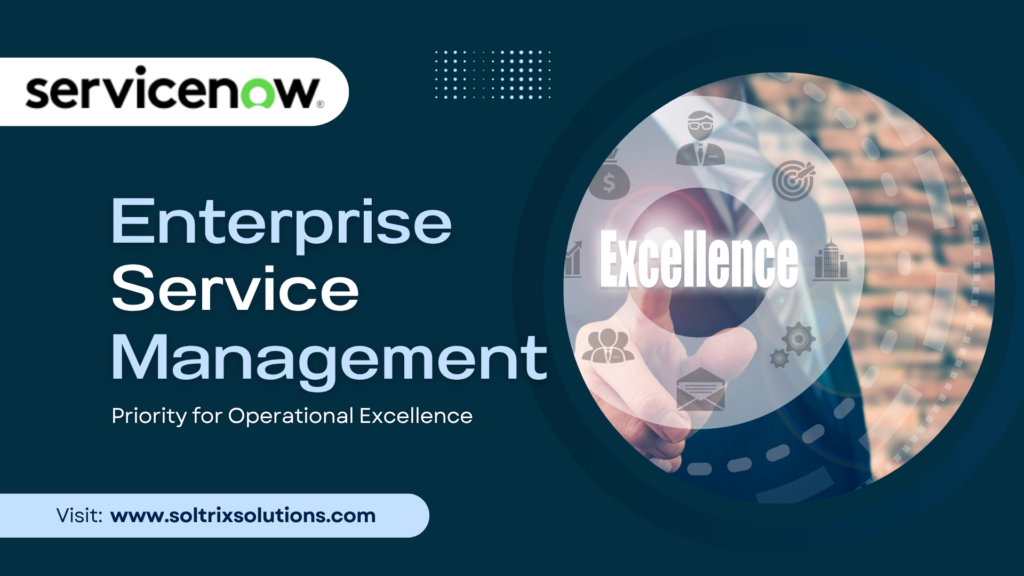
Introduction
The Enterprise Service Management (ESM) market is expected to reach US$12.8 billion by the end of 2025, with a compound annual growth rate (CAGR) of 18–20%. This shows that businesses are putting a lot of money into unified platform strategy across all departments (Serviceaide). For businesses today looking at enterprise-grade tools, ServiceNow Enterprise Service Management is more than just another option; it’s the key to making operations run more smoothly.
People are asking, “Is ServiceNow an ERP?” or “Is ServiceNow a CRM or ERP system?” It’s important to make it clear that ServiceNow is not a traditional ERP. However, it does have ESM features that let it do many of the same things that an ERP would do for HR, finance, facilities, and IT, but without the problems that come with old ERP systems.
According to McDermott, the CEO of ServiceNow, AI-integrated workflow tools are going to change how businesses function (Investors). It’s time to learn why ESM is so important in 2025.
What is the Enterprise Service Management feature of ServiceNow?
Breaking Down Departmental Silos
The old ITSM, which was all about IT, has changed. ESM applies similar ideas to HR, finance, facilities, and customer service, bringing all of these services together under one digital roof (itsm.tools). This method gives businesses more freedom and makes it easier for users to become used to ERP ServiceNow features.
A Platform for the Modern Enterprise
ServiceNow Enterprise Service Management is built on the strong ServiceNow platform. It has self-service portals, automated workflows, and AI-powered analytics that help you connect your business strategy with how you run your organization. It isn’t a full-fledged ERP system, but it is a modern way to automate processes and coordinate operations.
Top Benefits for Business Operations
Cost Efficiency & Speed
AI assistance and workflow automation can cut down on human work by as much as 45%, which means a quick return on investment, especially for businesses that want to avoid costly ERP implementation expenses.
Cross-Department Collaboration
ESM brings together requests and approvals from HR, finance, IT, and facilities, making communication easier and cutting down on redundancy.
Compliance & Governance
Standardized processes make it possible to trace things and be ready for an audit, which is very important for data, legal, and financial governance.
Analytics and Visibility
Executives get dashboard-level information about service performance, bottlenecks, and resource use, which is very important for planning.
Real-World Use Cases and ROI:
Onboarding Employees
One platform starts the IT provisioning, HR paperwork, facilities setup, and finance workflow, which cuts onboarding time by more than half.
Requests for Facilities and Maintenance
Self-service portals for maintenance assistance cut down on ticket volume and speed up response times by more than 30%.
Help Desk for Money
Using a single ServiceNow portal to handle invoice tracking and reimbursement makes it easier to get approvals and keeps better track of finances.
Strategic 2025 Trends for ESM
AI/NLP & Generative AI
Sixty percent of CEOs want to add automated chatbots and predictive routing to their ServiceNow platforms for Enterprise Service Management.
ESM Platforms That Are Cloud-First
Organizations can scale up, control costs, and deliver faster with cloud-based ServiceNow ERP-like platforms that are projected to take over the industry.
Low-Code Workflow Development
As more and more businesses need custom apps, platforms like App Engine give business analysts the freedom to create workflows, which means they don’t have to rely as much on traditional ERP developers.
How to Make a Good ESM Plan
1. Begin with use cases that have a big effect
Put onboarding and IT service requests at the top of your list to show results. Then use ServiceNow ESM to scale across departments.
2. Get others involved At first
Get HR, facilities, and finance professionals involved early to help develop requirements and rules for governance.
3. Use AI and Low-Code Tools
Use App Engine or Virtual Agent to give business teams the power they need, just like how lightweight ERP ServiceNow models are taking the place of older ERPs.
4. Find the value and make it better
Keep an eye on KPIs like how long it takes to resolve an issue, how many requests you get, and how happy your customers are. Use these numbers to make your ServiceNow Enterprise Service Management setup the best it can be.
Conclusion
Companies need to move beyond fragmented platforms by 2025. Enterprise Service Management ServiceNow gives you a single, smart, and cloud-native platform that makes all of your departments more efficient. When companies look at choices like ERP vs. ServiceNow, they’ll see that ServiceNow fills the gap between old-fashioned ERP systems and flexible service platforms.
Organizations should:
- Launch pilot programs in core departments
- Use AI and low-code tools for agility
- Build enterprise-wide buy-in for long-term value
The future is connected—ServiceNow ESM brings operational harmony, visibility, and intelligent service delivery.
FAQ’s
Q1: What is the ServiceNow Enterprise Service Management?
A1: ServiceNow is a way to manage services in HR, IT, finance, and other areas without having to set up a full ERP system.
Q2: Is ServiceNow a system for managing businesses?
A2: No, however ServiceNow ERP features help automate and manage key operations like traditional ERPs do, but without the extra costs.
Q3: What kind of return on investment (ROI) can an ESM platform give?
A3: Most businesses see a return on investment (ROI) within 6 to 12 months. Automation cuts down on manual work by as much as 45%, and service efficiency goes up a lot.
Q4: Is ServiceNow a CRM or an ERP?
A4: ServiceNow isn’t a CRM or ERP in the usual sense, but it does have some of the same basic features that help with workflow, automation, and service delivery.
Q5: How does ERP ServiceNow fit into the daily operations of a business?
A5: It offers a lighter alternative to ERP by digitizing workflows, approvals, and service operations across corporate units.